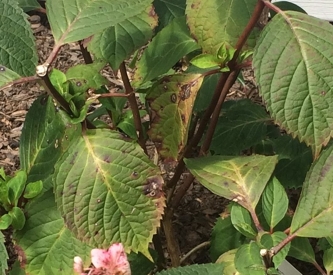The Facts About Hydrangea Leaves Turning Yellow Uncovered
Wiki Article
The 25-Second Trick For Hydrangea Leaves Turning Yellow
Table of ContentsWhat Does Hydrangea Leaves Turning Yellow Mean?Hydrangea Leaves Turning Yellow - TruthsGetting The Hydrangea Leaves Turning Yellow To WorkOur Hydrangea Leaves Turning Yellow Ideas
Big leaves usually look saggy during the mid-day warm. When they fall short to perk up in the evening or still look shrivelled in the morning, your plant can be overwatered.Get rid of the plant from the soil and prune out any origins that aren't white and swollen (plump). Replant in a new place or work some sand into the dirt for better drainage.
Add a little bit of distilled water, mix the ingredients, and drain the extra water. Put a p, H screening strip in and wait for a reading.
The very best means to do that is with dirt changes. Sphagnum moss or peat moss avoids the dirt from condensing and betters dirt water drainage while likewise elevating the dirt's level of acidity. You can spread sulfur chips in your hydrangea dirt. Nevertheless, the simplest method is to just make use of a fertilizer that helps maintain the appropriate level of acidity in the dirt while likewise feeding the plant.
Hydrangea Leaves Turning Yellow Things To Know Before You Buy
This is one good factor to repot houseplants on a regular basis (though there are others, such as origin advancement as an example). It is likewise why houseplants require a much stricter fertilizing regular than the majority of outdoor plants. When a hydrangea houseplant is deficient in nutrients, its fallen leaves will be the initial to show the signs.
The majority of liquid fertilizer calls for dilution with water to minimize the concentration somewhat. You will likewise need to feed the plant by hand and regular intervals. When springtime starts in March, it's the active growing season for several houseplants, consisting of hydrangeas. Now, you must begin your feeding routine. Apply fluid plant food to your hydrangea due to the fact that this things, as I stated previously, is fast-releasing.
The dripline is the area located under the vegetation that is the furthest far from the center of the plant. So as opposed to using feed to the center of the plant it is best to concentrate it mainly in the outer areas go to my site of the pot. If you would certainly rather use a slow-release plant food such as granular or spike plant food, then cover either kind with some dirt after you insert them.
See This Report about Hydrangea Leaves Turning Yellow

Although the hydrangea is remarkably frost-resistant, once temperatures start obtaining right into the 20s, the plant is in serious risk. If the temps are in the reduced 10s, that danger is extra severe still. Undoubtedly this is more of a worry with exterior plants so if you keep potted hydrangea outside you ought to bring them inside in extremely cool climate problems and even take into consideration relocating them inside for the period of the winter months.

A dehydrated hydrangea, A huge trouble with many houseplants is origin rot. Origin rot occurs when you overwater a plant and due to the fact that it is such an usual issue (especially with succulents) lots of houseplant proprietors are fearful of overwatering their plants. However, hydrangeas need even more watering that most other usual houseplants and Check This Out can come to be dried out when they are underwatered (Hydrangea Leaves Turning Yellow).
Hydrangea Leaves Turning Yellow for Beginners
Be definitely sure that your hydrangea is dehydrated due to a lack of water and not due to it be provided too much water (a lot more on this later). Overwatering is a serious problem if you cut corners on its water needs even a little bit, your hydrangea will be quick to reveal it.The very best means to establish if your hydrangea is underwater is to inspect the wetness degrees in the soil. By utilizing an effective but low-cost wetness and p, H tester, or by sticking your finger into the dirt, you will promptly inform if the plant needs water. To obtain your hydrangea sprinkling routines on the appropriate track, you require to be mindful about the wetness levels in its soil.
When you remove your finger from moist dirt it will certainly have small quantities of dirt residue stuck to it. Dry dirt will imply your finger comes out clean or with completely dry soil that is quickly blown away. If it's wet, and the plant has yellow fallen leaves then the plant has likely been overwatered and you will certainly require to adhere to the advice offered in the section listed below.
Report this wiki page